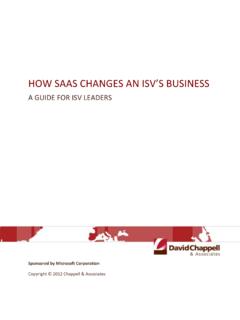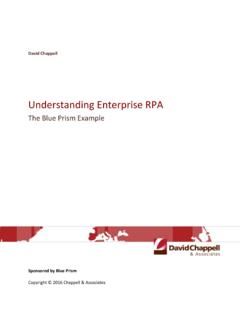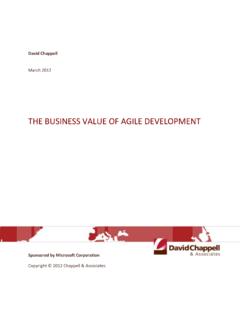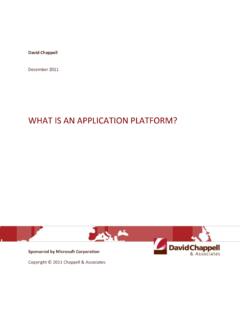Transcription of Introducing Blue Prism
1 David Chappell Introducing blue Prism Robotic Process Automation for the Enterprise Sponsored by blue Prism Copyright 2017 Chappell & Associates 2 Contents Robotic Process Automation with blue Prism .. 3 What is Robotic Process Automation? ..3 The Value of Robotic Process Automation ..4 An Overview of blue Prism ..5 A blue Prism Scenario ..7 The Technology of blue Prism .. 9 Creating blue Prism Applications: Business Objects ..9 What is a Business Object? ..9 Creating an Application Creating Actions ..12 Creating blue Prism Applications: Processes ..15 What is a Process? ..15 Creating a Process ..16 Deploying blue Prism Applications ..18 Managing blue Prism Applications ..19 Securing blue Prism Applications ..21 Conclusions .. 22 About the Author .. 22 3 Robotic Process Automation with blue Prism Doing more with software is the essence of digital transformation. An important part of this transformation is automating business processes, using software rather than people wherever possible.
2 Robotic process automation (RPA) is an increasingly popular approach to doing this. RPA can have a transformative impact on organizations, bringing lower costs, increased reliability, and faster process execution. Done well, it can also let IT and business people work together to implement and change automated processes quickly. This paper introduces RPA, then describes how it s provided by blue Prism , a leading vendor in this market. The goal is to explain what RPA is and how blue Prism supports it. What is Robotic Process Automation? Even in our digital era, many business processes are still carried out by people. Yet these processes commonly rely on one or more applications, with human beings providing the driving intelligence. For example, think about a back office that handles customer orders. Each order might require getting a customer s name, then looking up and validating the customer s shipping address. Once this information is available, the next steps might be to calculate the shipping cost and place the order.
3 In a typical back office environment, people execute this process, often relying on multiple applications to complete it. But why? Just as more and more manufacturing processes are now done by robots, why can t more and more business processes be done by software robots? The answer is that with RPA, they can. Put simply, RPA means using software rather than people to carry out business processes that rely on applications. Figure 1 illustrates this idea. Figure 1: Robotic process automation allows using software robots rather than people to drive business processes. As the figure shows, RPA allows replacing people with software robots. While this kind of automation can be useful when a process uses just one application, it s especially valuable when a process relies on multiple applications, as in the example shown here. Rather than integrating the applications through whatever application programming 4 interfaces (APIs) they might expose, RPA instead accesses each one through its user interface, just as a person would.
4 For the right kinds of processes, the economics of a robotic workforce are appealing. In fact, RPA can sometimes bring enormous benefits, especially for large enterprises. Think about it: Software robots can work every day around the clock, and they aren t tempted to take shortcuts. If your workload increases, you don t have to hire, train, and deploy new people; you just run more robots. If your workload decreases, you don t need to lay anybody off; you just shut down some robots. blue Prism , a UK-based technology company, provides software for RPA. (In fact, they coined this now industry-standard term.) This paper describes blue Prism s offering, which is also called blue Prism . Before diving into the technology, though, it s worth taking a closer look at why organizations choose to use RPA. The Value of Robotic Process Automation Automating processes using RPA has a lot going for it. Among its attractions are the following: Automating a process using RPA is typically simpler than using API-based integration.
5 It also requires less technical knowledge and can be done faster. Automating a process using RPA is usually less expensive than using API-based automation. Because of this, you can automate more business processes for less money. And while API-based automation is typically used only for very high-value processes, RPA can provide a return on investment even for processes with lower business value. For example, maybe an application s transaction volumes don t justify the effort and expense of API-based automation. Using a lower-cost RPA approach can make this automation viable. Once a structured development process is in place, RPA can let business people create their own software robots. This frees the business from total reliance on IT for process automation. Just as important, RPA can let business people change their automated business processes without making every change request go through the IT bottleneck. Software robots make processes more accurate.
6 Unlike people, they don t get tired and make mistakes. They just execute the defined process precisely over and over and over. RPA can also improve data quality, since input errors made by people go away. Applications accessed via RPA needn t expose any APIs. Instead, software robots rely on the same user interfaces that people use. This also lowers the risk of automating a process, since connecting with applications through APIs can provide more direct and potentially more damaging access to their functionality. In many applications, including modern web applications and older client/server solutions, important parts of the business logic are implemented in the user interface. On the web, for example, data validation is frequently done in JavaScript running in the browser. RPA takes advantage of this, something that s harder to do with API-based process automation. RPA allows automatically logging what would otherwise be manual operations in a business process.
7 These logs are then available for audit, providing a written record of the process. This can be useful for things such as determining why a process raised an exception and meeting regulatory requirements. 5 As this list suggests, RPA is often a good choice for automating business processes. It s worth noting, though, that API-based automation can sometimes yield better performance. For example, suppose the information required for a single operation is spread across several different web pages or screens. While API-based automation might be able to access that information in one chunk, using RPA might mean stepping through all of the required pages or screens (although RPA technologies can also potentially access these APIs). Like every technology, RPA has pros and cons. It s the right choice for some scenarios, but not for everything. Here are some of the characteristics of a process automation project for which this approach is a good fit: Getting a solution running quickly and inexpensively is important.
8 The business process doesn t need to handle extremely high transaction volumes. The business process changes frequently, and business people need to be able to make those changes themselves. The business value of automating a process isn t high enough to justify the investment required for API-based integration. For example, think about automating a business process that spans a range of different applications from different eras, including recently built web apps, client/server software, and 25-year-old mainframe software. If the goal is to create an automated process that handles tens of thousands of transactions a day, if the process doesn t change often, if all of these applications expose the right APIs, and if the time and money are available, API-based process automation is probably the best choice. But if the automated process is needed quickly at lower cost, if it might change frequently, if it need handle only a few thousand transactions a day, or if the right APIs aren t available, using RPA is probably a better approach.
9 An Overview of blue Prism blue Prism is a set of tools, libraries, and runtime environments for RPA. Figure 2 illustrates the product s main components. 6 Figure 2: blue Prism lets business analysts and developers create software robots using business objects and processes, then manage those robots. Each software robot has two main parts: one or more business objects that interact with the user interfaces of the applications this robot uses, and a process containing the logic that drives the robot. blue Prism has built-in support for connecting business objects to various kinds of application user interfaces, including browser-based HTML interfaces, Windows interfaces, mainframe applications accessed via terminals, and interfaces built using Java. Each business object implements a particular set of actions against an application s user interface. For example, a single business object might be capable of logging in to an application, entering a customer name into a particular screen, retrieving a result, then logging off.
10 A developer or business analyst uses a blue Prism development tool called Object Studio to create these objects graphically writing code isn t required. The creator of this robot also uses another blue Prism development tool, Process Studio, to graphically define the steps in the robot s process. Each step in a process invokes actions in business objects to interact with an application, and once again, writing code isn t required. In a very real sense, a process acts like a human user accessing each application to carry out the business process. To store business objects, processes, and other information, the product provides the SQL Server-based blue Prism database. IT and business people can use blue Prism s management tools to schedule when robots run, view information about running robots, and more. These tools also allow configuring users, viewing audit logs, and performing other management tasks. And to make life simpler for the people using the product, all of blue Prism s client tools are provided as tabs in a single application called the Interactive Client (IC).

















